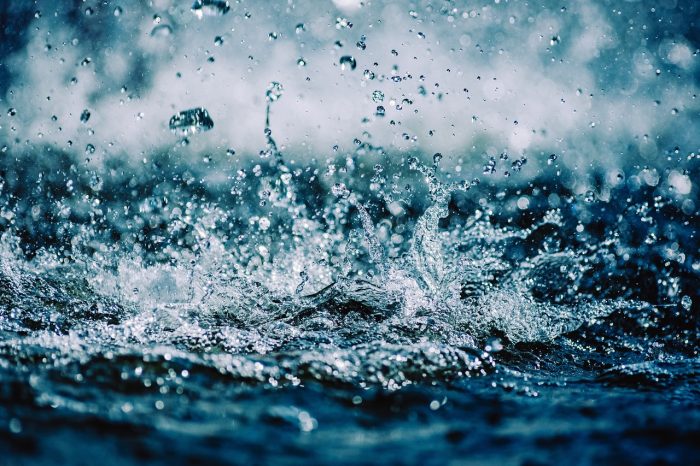
Water’s peculiar qualities are vital to maintaining life as we know it. This makes it one of the most important substances for all life on Earth. These characteristics result from the unique interactions and arrangements of its molecules. Two hydrogen atoms covalently bond to one oxygen atom to form a bent shape.
Here are 3 main properties of water
Surface Tension of Water
Insects’ ability to hop from one surface to another has long baffled scientists. This is caused by surface tension. As they strive to occupy as little space as possible, molecules on a liquid’s surface experience surface tension, similar to an elastic sheet.
Surface particles strongly attract their internal counterparts in the liquid. As these outside particles are drawn into the liquid, the liquid takes on the shape of the smallest possible surface area. Because of this attraction, the liquid’s surface can resist outside forces, like an insect’s weight. The hydrogen bonds between water molecules give it a very high surface tension. The cohesive properties of water are on display once again.
Cohesive Properties
A substance’s cohesiveness is its capacity for its constituent particles to cling to one another. Droplets appear when a small amount of water splashes across a surface. This is where cohesion occurs. Water molecules cluster together rather than disperse evenly. This is due to the fact that nearby water molecules form hydrogen bonds.
Adhesive Properties
Adhesion is the capacity of one material’s particles to adhere to another. When you pour it in, it looks like the water is climbing the sides of the test tube. A meniscus is the final result of this process. To be absolutely precise, you must measure the water volume from the base of the meniscus. You can see an example of adhesion here. Through hydrogen bonding, water binds with another substance—in this case, the test tube walls.
How does pH affect water quality?
The pH value is one way to determine how acidic or basic a solution is, like water, by looking at its pH value. Because it influences so many different biological and chemical processes in water, it is a crucial parameter for assessing water quality. The following is how pH affects water quality:
- Water Treatment
pH levels are used in water treatment. For instance, altering the pH of treated drinking water is a common practice to maximize the efficiency of disinfection methods like chlorination. pH can also impact the effectiveness of the flocculation and coagulation procedures for purifying water during treatment.
- Buffering Capacity
The term “buffering capacity” refers to water’s resistance to pH changes caused by the introduction of acids or bases, and pH also influences this resistance. Aquatic habitats are more stable in bodies of water with a high buffering capacity. This is because they are less susceptible to fast fluctuations in pH.
- Chemical Reactions
pH affects how substances react in water. It can impact the toxicity, availability, and solubility of many chemicals. Aluminum, copper, and lead are just a few metals that can become more soluble and perhaps more poisonous in acidic environments. Conversely, plants may have an easier time absorbing nutrients such as nitrogen and phosphorus in slightly acidic to neutral pH ranges.
- Biological Processes
In algae and aquatic plants, pH influences biological activities such as respiration and photosynthesis. Because these activities are pH-dependent, large pH variations can have a domino effect on aquatic plant growth and productivity. This, in turn, can influence the whole aquatic environment.
- Aquatic Life
pH can have a significant impact on aquatic life. Various aquatic creatures, including plants, insects, and fish, have preferred pH ranges for optimal growth and survival. These creatures are vulnerable to stress or death from pH fluctuations outside these ranges. For instance, fish can suffer gill damage in acidic environments, and aquatic plants might have their essential minerals and nutrients impacted in alkaline (high pH) ones.
Water quality and the health of aquatic ecosystems depend on keeping pH levels within a reasonable range. To keep water resources healthy and sustainable, it is essential to monitor pH levels on a regular basis and respond appropriately to any changes.
What is ppm in water?
A common unit of measurement for expressing a substance’s concentration in water or other liquids is “parts per million” (PPM). This expression indicates the number of units of the substance present in one million units of the liquid or water.
For instance, in the case of calcium ions, a concentration of 100 parts per million in water indicates that there are 100 parts per million ions in every million parts of water.
Chemicals, contaminants, soluble minerals, and pollutants are only a few of the many things whose concentrations in water you can measure in parts per million. It has extensive applications in environmental monitoring and water quality testing, as well as in manufacturing and the food and beverage industry.
 What brings about poor water quality?
What brings about poor water quality?
Numerous natural and man-made factors can contribute to poor-quality water. Several major factors can lead to water not being up to par.
- Poor Infrastructure
Waterborne illnesses and pollution can result from inadequate or outdated water treatment and distribution infrastructure, compromising water quality.
- Sedimentation
Sedimentation in water bodies reduces water quality and clarity. Additionally, incorrect land use practices, building activities, and deforestation cause soil erosion, leading to sedimentation.
- Changes in climate
Climate change-related changes in rainfall and temperature patterns can affect water quality through nutrient cycling, habitat changes, and the severity of extreme weather events like droughts and floods.
- Nutrient Pollution
Eutrophication can cause algal blooms and oxygen depletion in water bodies. This is due to excess nutrients like phosphorous and nitrogen from sources like fertilizers, sewage discharge, and agricultural runoff.
- Habitat destruction
Alteration or destruction of rivers, wetlands, and other aquatic habitats can lead to water quality degradation. This can reduce biodiversity and interfere with natural filtration mechanisms.
- Pathogens
Water contamination by pathogenic microbes such as protozoa, viruses, and bacteria can result from sewage leakage, inappropriate waste disposal, and insufficient sanitation.
- Invasive species:
Introducing invasive species to aquatic ecosystems can alter water quality and ecosystem function, upsetting the ecological balance.
- Pollution
Runoff from agriculture, industry, and urban areas can contaminate water sources with sewage, chemicals, fertilizers, pesticides, and heavy metals.
- Acidification
Surface water ecosystems and the organisms that inhabit them are vulnerable to acid rain, which is a byproduct of air pollution.
It is common for a combination of public education and awareness campaigns, sustainable land management practices, regulatory actions, investments in water infrastructure, and pollution control techniques to address water quality issues.
Conclusion
Maintaining ecosystem balance, protecting human health, and supporting aquatic life all depend on water that is of high quality. Management practices and regular monitoring are necessary to keep water resources clean and sustainable.
